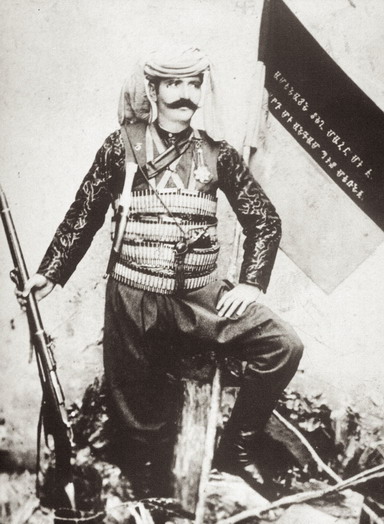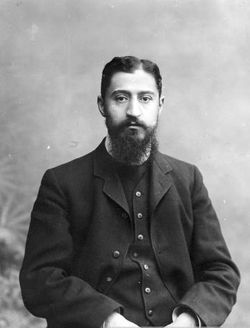|
Tsatur Aghayan
Tsatur Pavel Aghayan (; – 3 December 1982) was a Soviet-Armenian historian, a professor at Yerevan State University, an academician of the Armenian Academy of Sciences, the editor of the journal '' Lraber Hasarakakan Gitutyunneri'', and a renowned scientist of the Armenian SSR (1974). Aghayan was born in the village of Pip, Dashkesan. He headed the branches of Soviet and modern history at the Institute of History (Armenian Sciences Academy), and from 1961 to 1968, he directed the Armenian branch of the Institute of Marxism-Leninism. His works are dedicated to the Armenian National Liberation Movement of the 19th and 20th centuries, Andranik Ozanian's activities, and the socioeconomic conditions of pre-Soviet Transcaucasia. He died in 1982 in Yerevan. He is buried in the Tokhmakh cemetery with Siranush Aghayan Simoni. Works *From the history of Armenian people's liberational movement, Yerevan, 1976, *Revolutionary movements in Armenia 1905–1907, Yerevan, 1955. References ... [...More Info...] [...Related Items...] OR: [Wikipedia] [Google] [Baidu] |
Great Soviet Encyclopedia
The ''Great Soviet Encyclopedia'' (GSE; , ''BSE'') is one of the largest Russian-language encyclopedias, published in the Soviet Union from 1926 to 1990. After 2002, the encyclopedia's data was partially included into the later ''Great Russian Encyclopedia'' in an updated and revised form. The GSE claimed to be "the first Marxist–Leninist general-purpose encyclopedia". Origins The idea of the ''Great Soviet Encyclopedia'' emerged in 1923 on the initiative of Otto Schmidt, a member of the Russian Academy of Sciences. In early 1924 Schmidt worked with a group which included Mikhail Pokrovsky, (rector of the Institute of Red Professors), Nikolai Meshcheryakov (Former head of the General Directorate for the Protection of State Secrets in the Press, Glavit, the State Administration of Publishing Affairs), Valery Bryusov (poet), Veniamin Kagan (mathematician) and Konstantin Kuzminsky to draw up a proposal which was agreed to in April 1924. Also involved was Anatoly Lunacharsky, People' ... [...More Info...] [...Related Items...] OR: [Wikipedia] [Google] [Baidu] |
Transcaucasia
The South Caucasus, also known as Transcaucasia or the Transcaucasus, is a geographical region on the border of Eastern Europe and West Asia, straddling the southern Caucasus Mountains. The South Caucasus roughly corresponds to modern Armenia, Georgia, and Azerbaijan, which are sometimes collectively known as the Caucasian States. The total area of these countries measures about . The South Caucasus and the North Caucasus together comprise the larger Caucasus geographical region that divides Eurasia. The South Caucasus is a dynamic and complex region where the three countries have pursued distinct geopolitical pathways. Geography The South Caucasus spans the southern portion of the Caucasus Mountains and their lowlands, straddling the border between the continents of Europe and Asia, and extending southwards from the southern part of the Main Caucasian Range of southwestern Russia to the Turkish and Armenian borders, and from the Black Sea in the west to the Caspian Sea coa ... [...More Info...] [...Related Items...] OR: [Wikipedia] [Google] [Baidu] |
Academic Staff Of Yerevan State University
An academy (Attic Greek: Ἀκαδήμεια; Koine Greek Ἀκαδημία) is an institution of tertiary education. The name traces back to Plato's school of philosophy, founded approximately 386 BC at Akademia, a sanctuary of Athena, the goddess of wisdom and skill, north of Athens, Greece. The Royal Spanish Academy defines academy as scientific, literary or artistic society established with public authority and as a teaching establishment, public or private, of a professional, artistic, technical or simply practical nature. Etymology The word comes from the ''Academy'' in ancient Greece, which derives from the Athenian hero, ''Akademos''. Outside the city walls of Athens, the gymnasium was made famous by Plato as a center of learning. The sacred space, dedicated to the goddess of wisdom, Athena, had formerly been an olive grove, hence the expression "the groves of Academe". In these gardens, the philosopher Plato conversed with followers. Plato developed his sessions ... [...More Info...] [...Related Items...] OR: [Wikipedia] [Google] [Baidu] |
1982 Deaths
Events January * January 1 – In Malaysia and Singapore, clocks are adjusted to the same time zone, UTC+8 (GMT+8.00). * January 13 – Air Florida Flight 90 crashes shortly after takeoff into the 14th Street bridges, 14th Street Bridge in Washington, D.C., United States, then falls into the Potomac River, killing 78 people. * January 14–17, 2022 North American winter storm, January 14 – An Ethiopian Air Force Antonov An-26 with an unknown registration crashed near Addis Ababa, Ethiopia, killing all 73 occupants on board. * January 18 – 1982 Thunderbirds Indian Springs Diamond Crash: Four Northrop T-38 aircraft of the United States Air Force crash at Indian Springs Air Force Auxiliary Field, Nevada, killing all 4 pilots. * January 26 – Mauno Koivisto is elected President of Finland. * January 27 – The government of Garret FitzGerald in Republic of Ireland, Ireland is defeated 82–81 on its budget; the 22nd Dáil is dissolved. * January 30 – The first computer ... [...More Info...] [...Related Items...] OR: [Wikipedia] [Google] [Baidu] |
1912 Births
This year is notable for Sinking of the Titanic, the sinking of the ''Titanic'', which occurred on April 15. In Albania, this leap year runs with only 353 days as the country achieved switching from the Julian to Gregorian Calendar by skipping 13 days. Friday, 30 November ''(Julian Calendar)'' immediately turned Saturday, 14 December 1912 ''(in the Gregorian Calendar)''. Events January * January 1 – The Republic of China (1912–49), Republic of China is established. * January 5 – The Prague Conference (6th All-Russian Conference of the Russian Social Democratic Labour Party) opens. * January 6 ** German Geophysics, geophysicist Alfred Wegener first presents his theory of continental drift. ** New Mexico becomes the 47th U.S. state. * January 8 – The African National Congress is founded as the South African Native National Congress, at the Waaihoek Wesleyan Church in Bloemfontein, to promote improved rights for Black people, black South Africans, with Joh ... [...More Info...] [...Related Items...] OR: [Wikipedia] [Google] [Baidu] |
Yerevan
Yerevan ( , , ; ; sometimes spelled Erevan) is the capital and largest city of Armenia, as well as one of the world's List of oldest continuously inhabited cities, oldest continuously inhabited cities. Situated along the Hrazdan River, Yerevan is the administrative, cultural, and industrial center of the country, as its primate city. It has been the Historical capitals of Armenia, capital since 1918, the Historical capitals of Armenia, fourteenth in the history of Armenia and the seventh located in or around the Ararat Plain. The city also serves as the seat of the Araratian Pontifical Diocese, which is the largest diocese of the Armenian Apostolic Church and one of the oldest dioceses in the world. The history of Yerevan dates back to the 8th century BC, with the founding of the fortress of Erebuni Fortress, Erebuni in 782 BC by King Argishti I of Urartu, Argishti I of Urartu at the western extreme of the Ararat Plain. Erebuni was "designed as a great administrative and reli ... [...More Info...] [...Related Items...] OR: [Wikipedia] [Google] [Baidu] |
Andranik Ozanian
Andranik Ozanian, commonly known as General Andranik or simply Andranik (25 February 186531 August 1927), was an Armenian military commander and statesman, the best known '' fedayi'' and a key figure of the Armenian national liberation movement. He became active in an armed struggle against the Ottoman government and Kurdish irregulars in the late 1880s. Andranik joined the Armenian Revolutionary Federation (Dashnaktustyun) party and, along with other '' fedayi'' (militias), sought to defend the Armenian peasantry living in their ancestral homeland, an area known as Western (or Turkish) Armeniaat the time part of the Ottoman Empire. His revolutionary activities ceased and he left the Ottoman Empire after the unsuccessful uprising in Sasun in 1904. In 1907, Andranik left Dashnaktustyun because he disapproved of its cooperation with the Young Turks, the party which years later perpetrated the Armenian genocide. Between 1912 and 1913, together with Garegin Nzhdeh, Andranik l ... [...More Info...] [...Related Items...] OR: [Wikipedia] [Google] [Baidu] |
Yerevan State University
Yerevan State University (YSU; , , ), also simply University of Yerevan, is the oldest continuously operating public university in Armenia. Founded in 1919, it is the largest university in the country. It is thus informally known as Armenia's "mother university" (, ). Of its 3,150 employees, 1,190 comprise the teaching staff, which includes 25 academicians, 130 professors, 700 docents (associate professors), and 360 assistant lecturers. The university has 400 researchers, 1,350 post-graduate students, and 8,500 undergraduates, including 300 students from abroad. Instruction is in Armenian language, Armenian, but instruction in Russian language, Russian or English language, English for foreign students is available as needed. The academic year is from September 1 through June 30. According to University Ranking by Academic Performance (URAP), it was the top-ranked university in Armenia and the 954th in the world in 2010, of 20,000 institutions included in the list. Yerevan Sta ... [...More Info...] [...Related Items...] OR: [Wikipedia] [Google] [Baidu] |
Dashkasan District
Dashkasan District () is one of the 66 districts of Azerbaijan. It is located in the west of the country and belongs to the Ganja-Dashkasan Economic Region. The district borders the districts of Goygol, Kalbajar, Gadabay, Shamkir, and the Gegharkunik Province of Armenia. Its capital and largest city is Dashkasan. As of 2020, the district had a population of 35,400. History The district was established on 8 August 1930 and was known as ''Dastafur'' () until 1956, when it was changed to Dashkasan. The capital was established as an urban facility on March 16, 1948, after the end of World War I, mainly to explore and mine iron ore and other natural resources. Administrative divisions The rayon itself was founded as an administrative center in 1930 and was named Dastafur until 1956 when it was renamed Dashkasan. In 1963, the rayon status was eliminated and Dashkasan province was merged with Khanlar District. However, in 1965, it was split again and Dashkasan regained its ... [...More Info...] [...Related Items...] OR: [Wikipedia] [Google] [Baidu] |






